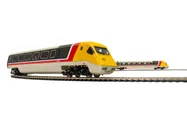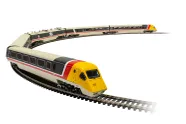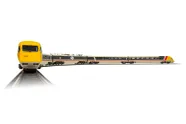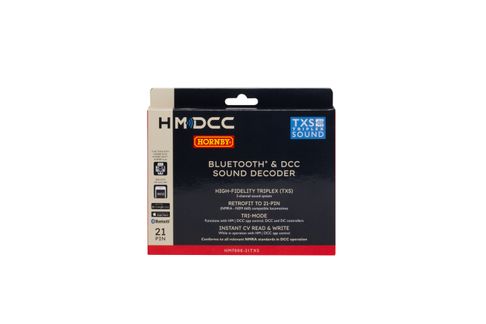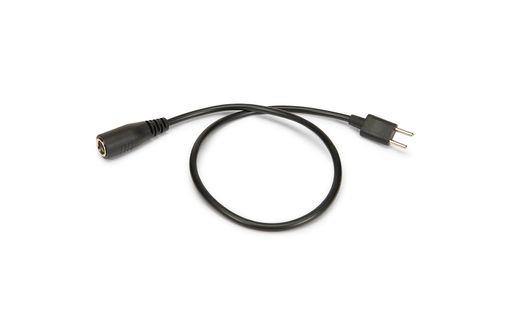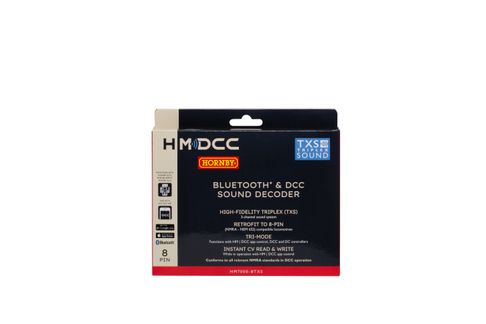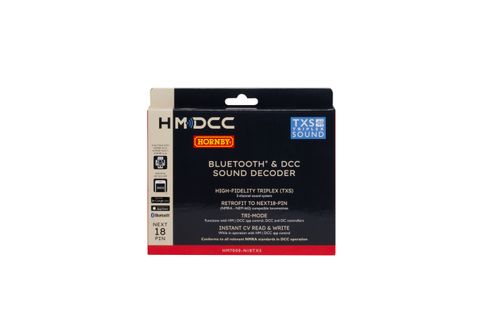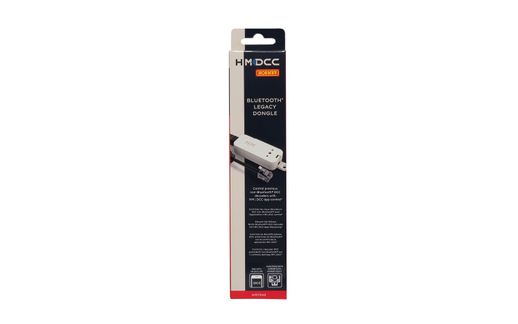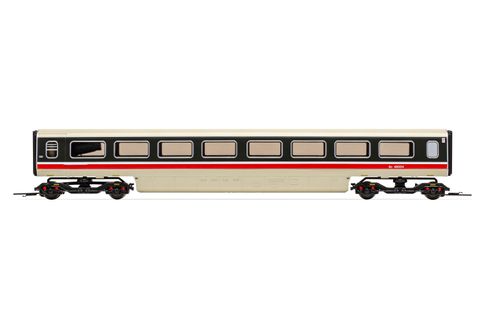R3873 BR, Class 370 Advanced Passenger Train, Sets 370 003 and 370 004, 5-car pack - Era 7

BR, Class 370 Advanced Passenger Train, Sets 370 003 and 370 004, 5-car pack - Era 7
Featuring an impressive set of passenger cars consisting of two driving units, two coaches and a non-driving motor unit, the APT 5-car pack encapsulates the historical character of the Advanced Passenger Train in its many forms. With a number of failures and successes, the APT is a thought-provoking addition to any model railway layout.
- 1:76 Scale
- 00 Gauge Compatible
- DCC Ready 8 pin socket

The BR, Class 370 Advanced Passenger Train, Sets 370 003 and 370 004, 5-car pack includes two driving units, two coaches and a non-driving motor unit.

With a number of formations and varying traction options, the APT-S, APT-R, APT-T, APT-U and APT-V projects never materialized.

The full 2+12 sets set a new time and speed record for the 401 mile trip between London and Glasgow. Additional cars are available to complete the fourteen car formation.
Images may be used for illustration purposes only.
Product Info
British Rail Class 370 Advanced Passenger Train 5-car Pack Set 370 003 comprising DTS Sc48103, TBF Sc48603 and NDM Sc49003 City of Derby, along with Set 370 004 comprising TBF Sc48604 and DTS Sc48104. By the end of 1970 the British Rail Board began considering the third design phase of the Advanced Passenger Train; the prototype for the full production trains that would incorporate the technology of the APT-E in a practical application.
From the outset the pre-production APT project, or APT-P, was considered to be nothing more than a proving prototype for evaluation, prior to the finalized Advance Passenger Train design being authorized for squadron service; the APT-S. Having settled on electric traction for the production APT, the West Coast main line between Euston and Glasgow was the obvious route for conducting testing, being electrified along its length and with some severe curves that curtailed high speed travel. The date for commencement of services was set for 1977 and the Chief Mechanical and Electrical Engineers' Department (CM&EE) design engineers began work in October 1973. In a move similar to the current situation of the DfT defining design specifications, it was the passenger business of British Rail that decided upon the original configuration for the APT-P. Each set was to comprise fourteen cars, with the two power cars marshalled at the outer ends of the sets.
It soon became clear that the use of two pantographs, one on each power car, was unsuitable for the OHP wires in place at that time and the use of two power cars in the middle of the train became the only option, effectively cutting the train in half. This created two 1+6 formations of DTS, TS, TRBS, TU, TF, TBF and NDM (Non-Driving Motor), through which passengers could not pass due to the high magnetic fields generated by the electrical equipment contained in the NDM. The NDM was the first vehicle completed for testing in June 1977 and it spent a year on static tests at RTC Derby, as well as dynamic tests on the WCML with a spare HST Power Car from September 1977.
In mid-1978 the power car was joined by the rest of the first half set for testing on the WCML and was unveiled to the press on June 7th but, hampered by industrial action, it was to be February 1979 before various formations of the full train were marshalled to test different aspects of the train. At the end of the year on December 20, 1979, a new rail speed record of 162.2mph was achieved and by March 1980 all three APT-P trains were delivered and ready for mileage accumulation on the WCML.
Having finally achieved full route clearance and with testing indicating that all was progressing to plan, shadow passenger service was set to commence on June 9, 1980 with a daily Glasgow/London return service. A demonstration run on April 18th with a 1+9 set was meant to usher in a new era of high speed rail travel, but a derailment caused by a faulty articulated bogie signaled the beginning of the APT 'jinx' and the postponement of passenger introduction. Wheelsets had to be rebuilt across the fleet and reliability problems with the tilt, transmission and braking systems were also exacerbated by the mediocre ride quality. It was also found that failure of the tilting mechanism could result in the APT exceeding its kinematic envelope and potentially coming into contact with an APT travelling in the opposite direction.
It was to be Spring 1981 before main line testing could resume and by now media and public opinion was turning against the project, with some individuals in Government and within the British Railways Board expressing their discontent as well. Entering public service on December 7, 1981 at first all went well, but very cold weather in Scotland on December 9th and again on December 11th resulted in the brakes freezing and the APT being taken out of traffic until the summer of 1982. A year of technical R&D project running followed, before limited passenger running took place across 1983/84 to assess passenger comfort using the full 2+12 sets between London Euston and Glasgow, culminating in a new time and speed record for the 401 mile trip of three hours and fifty-two minutes; an average speed of 103mph.
Far exceeding its budget, APT-P had now effectively reached the end of its development program. Although a number of plans had been suggested for the implementation of APT in service, in a number of formations and with varying traction options, the APT-S, APT-R, APT-T, APT-U and APT-V projects never materialized. The fleet of six sets had been reduced since March 1983, parts being canonicalized to keep the remaining vehicles running and at the end of May 1985 the APT-P was withdrawn from service, with the Intercity Development Train (APT-D) continuing until December 1986.
To complete your fourteen car formation, add the following SKUs (sold separately):
- R40011 (x2)
- R40012 (x2)
- R40013 (x2)
- R40014 (x2)
- R3948 (Motorized)
Welcome to the HM7000 Control System
HM7000 is an innovative way of controlling and operating model railways. Combining Bluetooth® technology and app-based control, the HM7000 Control System has been designed to revolutionise the controlling of a model railway.
Learn more
- Bluetooth® Connectivity
- Free Sounds
- Quick CV Editing
- Multiple Control Options
- 40+ Profile Settings
- Other Options
Upgrade Paths
Previous Control Systems can be upgraded to HM7000, see below for the options and upgrade paths available.
-
Train Set > HM7000
Already have a locomotive but want to go digital? Click here to discover how.
-
HM6000 > HM7000
The HM6000 system is only a short step away from having HM7000. Click here to discover how.
-
HM|DC > HM7000
New to the hobby? HM7000 is just a short step away. Click here to discover how.
-
DCC > HM7000
Already operating a layout using DCC? HM7000 is just a short step away. Click here to discover how.
-
Conventional DCC Controller > HM7000
Locomotives fitted with either a Hornby HM7000 or conventional decoders can be operated using the HM|DCC Bluetooth® system - click here to learn how.
HM7000 Products
The following points must be considered below when purchasing. HM | DCC and the HM7000 decoders have been extensively tested up to a range of 45 metres in plastic bodied locomotives and up to 12 metres in die-cast bodied locomotives. HM | DCC and the HM7000 decoders have been extensively tested up to a max of 14 non-stationary, running locomotives. HM | DCC and the HM7000 decoders have been extensively tested on iOS devices dating as far back as 5 years from today's date. Any devices older than this cannot be commented on for proper function by Hornby Hobbies. Please ensure that the incompatibility list is considered prior to any purchase.
What's Inside
Recommended For You
Tech Specs
- Item Length - Without Packaging (cm)
- 27.6
- Item Height - Without Packaging (cm)
- 5
- Item Width - Without Packaging (cm)
- 3.5
- Item Weight - Without Packaging
- 0.14
- Item Scale
- 1:76 Scale 00 Gauge
- License
- No
- Finish
- Painted
- Colour
- Grey
- Gauge
- OO
- DCC Status
- DCC Ready 8 pin socket
- Operator
- BR
- Designer
- BREL
- Livery
- Intercity Executive
- Minimum Curve (mm)
- Radius 2
- Motor
- 5 Pole Skew wound
- Number of Parts
- 5

WARNING! Not suitable for children under 36 months it contains small parts which can present a choking hazard and some components have functional sharp points and edges. Handle with care. Before giving the Toy to a child remove all packaging and any other component which is not part of the toy. Colour and contents may differ from those illustrated. Please retain these details and the address for future reference.
